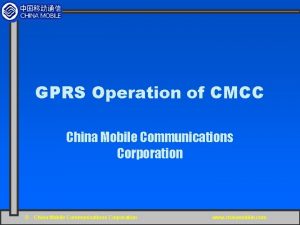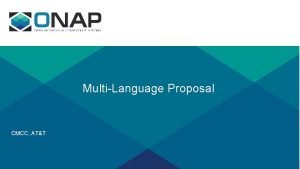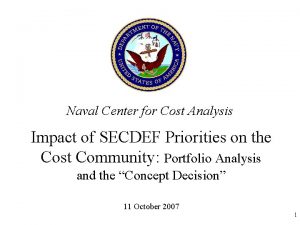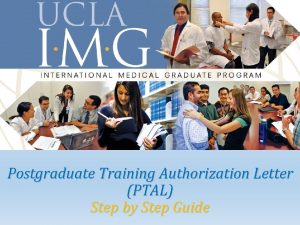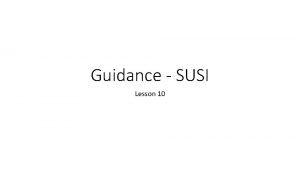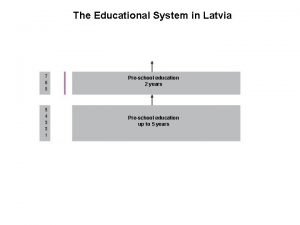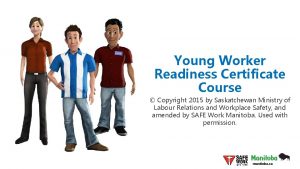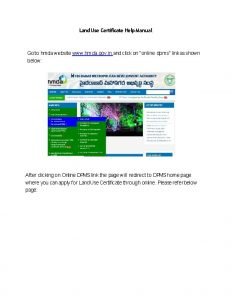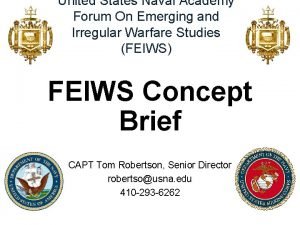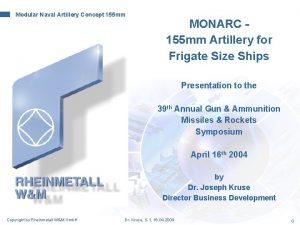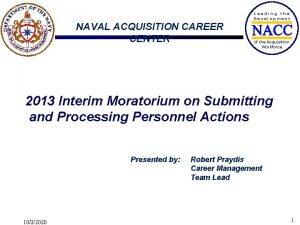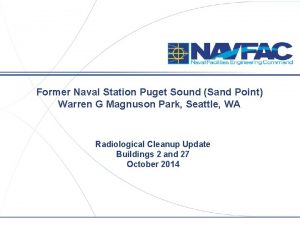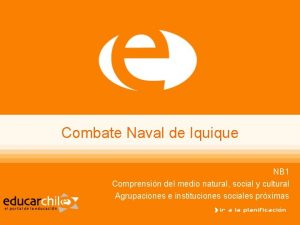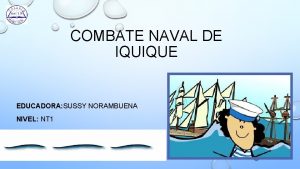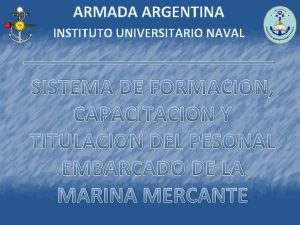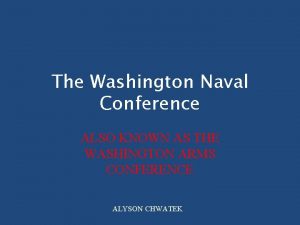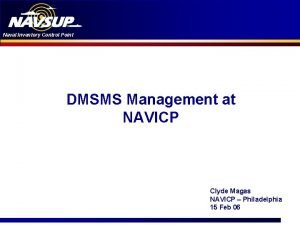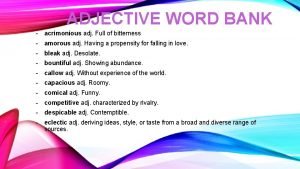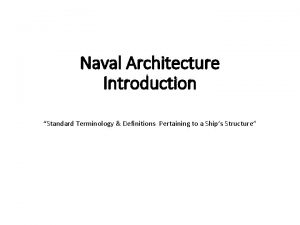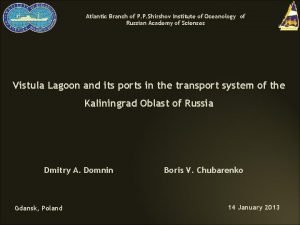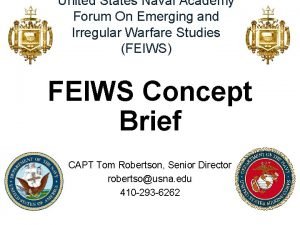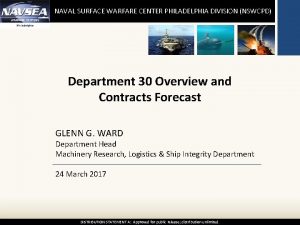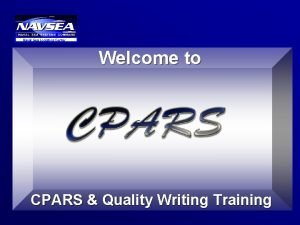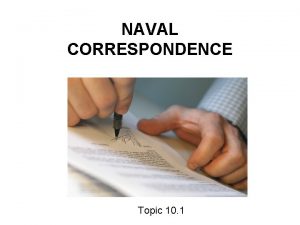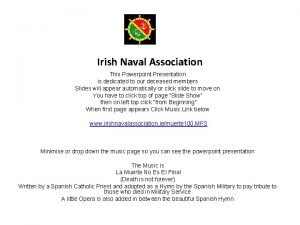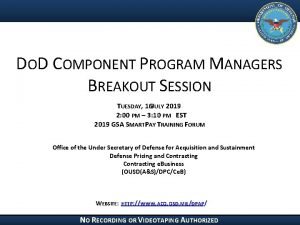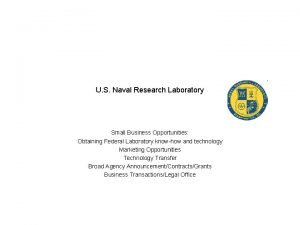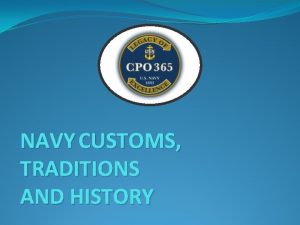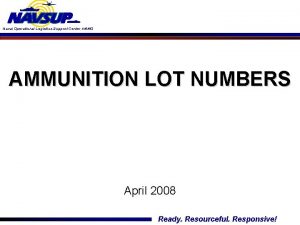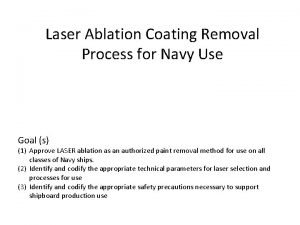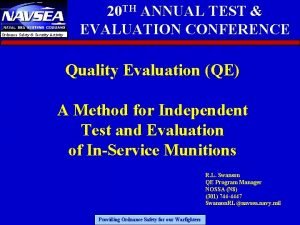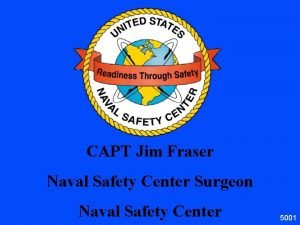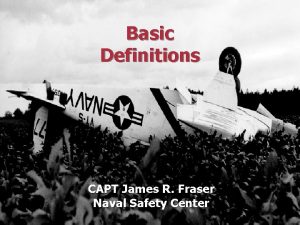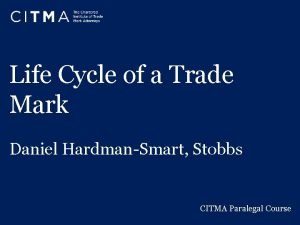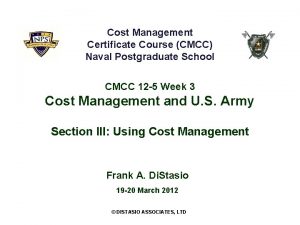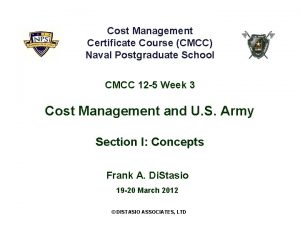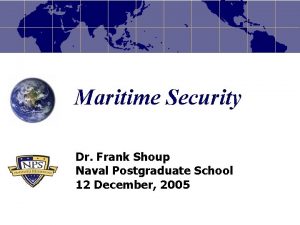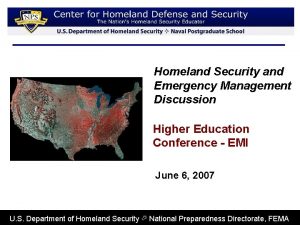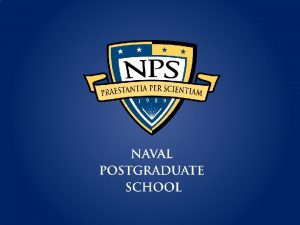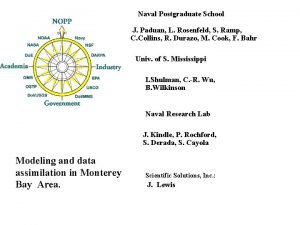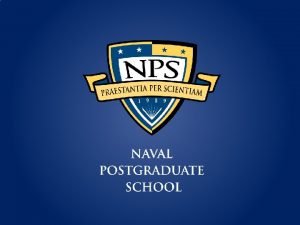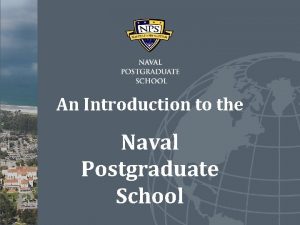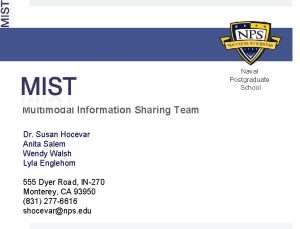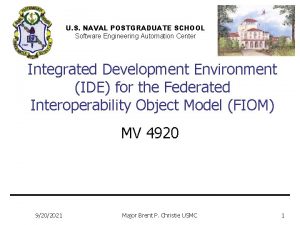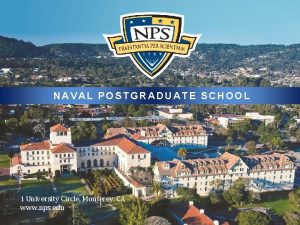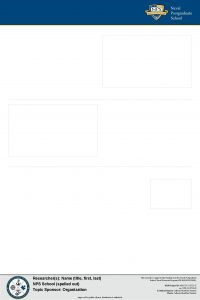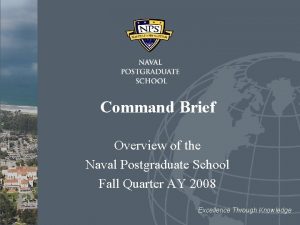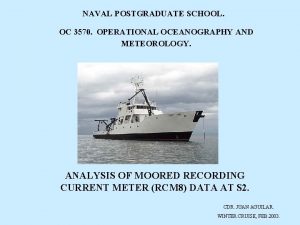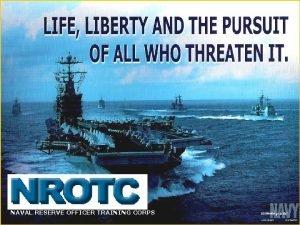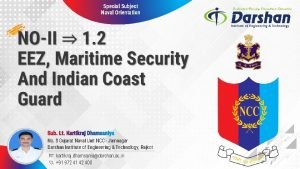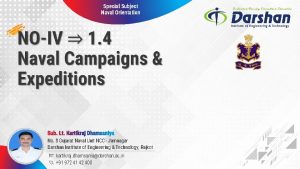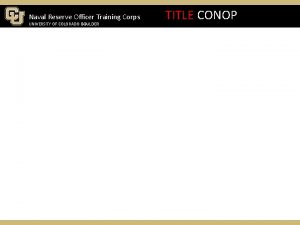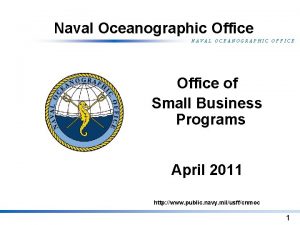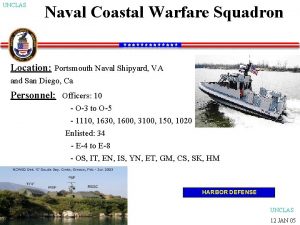Cost Management Certificate Course CMCC Naval Postgraduate School





















































- Slides: 53

Cost Management Certificate Course (CMCC) Naval Postgraduate School CMCC 12 -5 Week 3 Cost Management and U. S. Army Section III: Using Cost Management Frank A. Di. Stasio 19 -20 March 2012 © DISTASIO ASSOCIATES, LTD

Course Outline • Section I: Cost Management – – – Why cost management? Focus Concept of Operation Analysis Exercise • Section II: Cost Management and GFEBS – Development – Implementation • Section III: Using Cost Management – Cost culture – Cost controlling 9/16/2021 © DISTASIO ASSOCIATES, LTD 2

Hon. Mary Sally Matiella Use “… Cost-Conscious Way of Doing Business” January 2011 “The Secretary of Defense. . . to move Do. D toward a “ more efficient, effective, and cost-conscious way of doing business. ” “First. . . on GFEBS to execute disciplined, quarterly cost management reviews. ” 9/16/2021 “Second. . . use Cost. Benefit Analysis (CBA) or similar analytic approaches…. ” “Third. . . assess your organization’s current cost management program and develop a plan for improvement. ” 3

Hon. Mary Sally Matiella Use “… Cost-Conscious Way of Doing Business” “CMCC graduates have the training and expertise to play key roles in establishing and conducting. . . ” 9/16/2021 “. . . I look forward to … discuss the ways you are using cost information to make resource informed decisions. ” 4

Use “Cost-Conscience Way Of Doing Business” In Resourcing And Management Practices • Use Cost-Benefit Analysis (CBA) and similar analytic approaches in decision-making • Use cost controlling to assure efficient and effective use of resources 9/16/2021 5

Budget Formulation and Budget Execution Process Overview Formulation OMBPresident’s Budget Appropriations & Authorizations Budget Defens e Plannin g OSD Justification Books A Bill. . PBD Guidan ce • Appropriation • Authorization Program Objective Memorandum Budget Estimate Submission Treasury Execution HQDA Budget Requests Schedule 8 Schedule Army Commands Army Service Component Cmd Direct Reporting Unit 1 Record funds 9/16/2021 Financial systems (200+) for recording expenditure data Use funds OSD Fund Authorization Document HQDA Logistics Personnel Acquisition Installation Functional systems for recording performance, outcomes, output 6

Budget Formulation and Budget Execution Focus • Budget Formulation – Develop, review and approve request for funds – Produce Army portion of the President’s Budget – Participate in hearings and track Congressional “marks” • Budget Execution – Receive and distribute allotment – Use and control funds to accomplish mission – Report on the status of execution against the Budget NOTE: – Budget Formulation focuses on justification for funds and appropriation submission requirements – Budget Execution focuses on status of available funds, i. e. , commitments, obligations, expenses and disbursements (COED) Cost management can and must inform decision making in both phases to achieve best value 9/16/2021 7

Need To Use Cost Management Practices Budget Formulation and Budget Execution Army base budget about $145 billion Budget Formulation “request for money” 9/16/2021 Budget Execution “spend the money” 8

Use Cost Management In Budget Formulation and Budget Execution Legacy New Budget Formulation Budget Execution Budget » President’s financial plan and the priorities for the Fed Gov’t Focus » Requirements, priorities & risk Data Streams » Requirements, formulations Budget Authority » Authority to incur obligations Key Data Elements » Appropriation, FTE Key Data Elements » Appropriations, EOR’s, PE, MDEP, projects, BLIN, etc. Focus » Availability & obligations Data Streams » Budget, actual COED Cost analysis 9/16/2021 Cost Management Cost » Value of resources used to produce outputs & basis for decision making Focus » Full cost of output & best value Data Streams » Plan, target, actual expenses - cost, rates, performance measures Key Data Elements » Operational entity (e. g. cost centers), services, rates, products, projects, etc. Cost controlling 9

Everyone Needs To Use “…Cost-Conscience Way of Doing Business” “… each program decision is zero sum: a dollar spent for capabilities excess to our real needs is a dollar taken from a capability we do need – often to sustain our men and women in combat and bring them home safely. ” Secretary of Defense Robert Gates Opening Statement to the House Armed Services Committee, May 13, 2009 Not knowing cost makes things appear free and “free goods have infinite demand” 9/16/2021 10

“… to move DOD toward a “more efficient, effective, and cost-conscious way of doing business. ”” • Understand Cost Management concept: Manage business operations efficiently and effectively through the accurate measurement and thorough understanding of the "full cost" of an organization's business processes, products and services in order to provide the best value to customers • Adopt tools, processes and procedures – Cost accounting system – Integrating financial, cost and managerial/performance data – Applying cost management concepts and practices • Consider cost implications – all the time – in decision -making and actions Considering cost all the time is new 9/16/2021 11

Consider Cost All The Time • Why? – “It is simply not reasonable to expect the defense budget to continue increasing at the same rate it has over the last number of years. ” – “…each program decision is zero sum” – Not knowing cost makes things appear free and “free goods have infinite demand” • What does it take? – “… a cost-conscience way of doing business. ” – A culture 9/16/2021 12

“… way of doing business. ” A Cultural A culture is … • Attitudes, experiences, beliefs and values of an organization • Shared “taken-for-granted” assumptions, beliefs, values, expectations and rules • Held by members of a work unit team or a corporate organization • Shared behavior by people and groups in an organization Establishing a new culture involves: • Giving up all or part of the current culture • Assimilating the new culture 9/16/2021 13

“…cost-conscious way of doing business. ” A Cost Culture • Requires leaders, managers, soldiers and civilians to share a belief in “accomplishing the mission while considering the cost” • Requires using cost and performance information in decision-making – Understand both near- and long-term cost implications – Make effective trade-off decisions to achieve best use of limited resources – Hold subordinates accountable for improving the efficiency and effectiveness of operations Cost culture involves a move from “accomplish the mission at any cost” to “accomplish the mission considering cost” 9/16/2021 14

An Army Cost Culture • Includes deploying systems, improving cost models, issuing policies, recruiting experts, etc. ; but this alone will not enhance the Army’s ability to manage costs • Includes training leaders, managers, Soldiers and Army Civilians to… – Understand value the need to manage costs – Know costs manage concepts and practices • Must have leaders and managers demand cost information and use it in decision-making — as the normal way of doing business — otherwise the cost data provides no benefit ! “… focuses money where it can more effectively do just that [secure our nation]” -- Sec. Def Gatesc 9/16/2021 15

Army Cost Culture … A Real Change … a significant change “A Culture of Entitlement” • Budget-focused • Spend rate driven: inputs consumed 9/16/2021 “A Culture of Influence” • Cost and performance focused • Results driven: focus on output & outcome • Performance objective: 99. 9% obligation • Performance objective: optimize resources • Free goods have infinite demands • Full cost - use only what is necessary to obtain results 16

Cost Data Are Different Than Budget Execution Data Knowing your obligations is not the same as knowing your costs! Obligations: A legally binding commitment by the federal government that will result in outlays, immediately or in the future. Budgetary resources must be available before obligations can be incurred legally. Costs: The price or cash value of resources used (expenditures) to produce a program, project or activity. All relevant costs may not appear in the organization’s budget. Co dif st w of fer ill s y fu en co ll ion nd t y nt a c at nit i s, ea ain p c u y t llo s etc dif rs, ex Costs ” s a. , i fere dif pen st et ine Obligations o. e. nt fer l c udg us en ses l , “ o b u r Fu ga t s fro “F ds b ual ll C ni ou m d e i os zat rce ce div x t” ion Costs e in s, to Obligation 9/16/2021 17

“Full Cost” Definition • Sum of all costs required for a cost object including costs of activities performed by other entities regardless of funding sources • … an output produced by a responsibility segment is the sum of: (1) Costs of resources consumed by the segment that directly or indirectly contributes to the output, and (2) Costs of identifiable supporting services provided by other responsibility segments within the reporting entity, and by other reporting entities. Source: Statements of Federal Financial Accounting Standards (SFFAS) No. 4, Managerial Cost Accounting Standards and Concepts NOTE: Additional Cost Management guidance and definitions at AKO à Expand Do. D Organizations on site map à Expand Army Field Operating Agency à Click on ASA (Financial Management & Comptroller) link à Click on Cost Management Community of Practice link and Open CM Handbook or use this link: https: //www. us. army. mil/suite/page/593701 9/16/2021 18

“Full Cost” Is Important For Well-Informed Decisions Both - • Direct Cost: when the primary or initial expense is directly posted/charged to the cost object • Other Cost: necessary for the outcome or output – e. g. , for the consuming organizations, products or services, but not directly charged Note: Relating Other Cost to outcome or output (cost objects) involves either: – Assignment utilizing a generic rate and the quantity consumed (e. g. , Sq. Ft. ) for associating cost – Allocation utilizing a value based percentage to calculate an associated cost Avoid sub-optimization 9/16/2021 19

“Full Cost” Includes Direct And Other Relevant Costs • Direct Costs – A cost such as labor, materials/supplies that can be directly traced to producing a specific output of an organization, product/service. • Indirect Costs – A cost that cannot be directly traced to a specific organization, product/service output. • Funded Costs -- The value of goods or services received because of an obligation of funds (obligation authority), by the organization performing the work. • Unfunded costs -- A cost that are financed by another organization's or activity's appropriations. • Variable Costs -- A cost that changes with change in output. • Fixed Cost -- A cost that remains the same regardless of change in output. • Recurring Cost -- A cost that is incur repeatedly for each organization and/or product/service produced. • Non-Recurring Cost -- A cost that is unusual and unlikely to occur again. • Avoidable Costs -- A cost incurred on an object that will no longer be incurred due to a decision to change the output. • Unavoidable Cost -- A cost incurred on an object that will be incurred regardless of the decision to change. 9/16/2021 20

Dir Type Cost is a Function of … ect Ind ire or c Re t No curr n R ing e o Fix curr r ing ed Va ria or Fun ble d Un ed fun or Av ded oid Un able avo ida or ble Various Types of Cost Typically Relate To Various Functions Output Qty X X Product Produced X X X Source of Funds Overhead 9/16/2021 X X Provider X Relevant Time Range X X X 21

“Full Cost” Requires Relating Other Relevant Cost Assignment: Allocation: The establishment of relationship between a sending cost object and a receiving cost object based on a quantity (with a rate for valuation) being consumed by the receiver The establishment of a relationship between a sending cost object to one or more receiving cost object(s) based on % (even if a quantity is utilized to generate a %, e. g. # FTEs) Requires: • Activity Type or Business Process quantity as sender • A rate associated to valuate the quantity flow • Mechanism for capturing or imputing the sender quantity Requires: • Mechanism for capturing a quantitative or monetary value on the receiver(s) which is then utilized to determine the % split of the sender costs • Acceptance of batch processing $220 -$200 9/16/2021 Hr Order 1 Allocation Cost Center 2 $220 12 hr s@ = $1 $10 20 Order 2 -$220 Order 1 % Cost Center 1 0 $1 s @ $80 r 8 h = 50 Assignment 50% Order 2 22

“Full Cost” Assignment vs. Allocation Assignment: Allocation: Pros: • Direct relationship • Real-time information for analysis • Reduces systemic burden during period close • Dynamic (can change as the environment changes) • Capacity Management (resource utilization) Pros: • Provides mechanism for cost association when tracking of quantity is not possible or cost prohibitive Cons: • Must have the ability to track quantity from send to receiver or impute 9/16/2021 Cons: • Full-absorption approach • Typically less accurate • High demand on system resources during period-end close • Static assumption set often infrequently updated 23

Illustration Of Difference Between Budget Obligations and Full Cost Budget: Providers/Inputs Relating Cost: Outputs/Consumers Cost of Brigade Weapon Sys $ (VAMOSC) $ $ $ Direct $ $ Assign or allocate $ HQDA Direct Military Pay Contracts (CLS) Assign or allocate Army Service Component Commands Direct Reporting Unit Army Commands Unit Training • Ground OPTEMPO Installation • SSP 1 (Labor Tracking) School Training • Initial Entry Equip the Force • Acquisition 9/16/2021 Assign or allocate Direct GFEBS enables Army to “slice and dice” data for decision-making $ $ $ 24 24

Course Outline • Section I: Cost Management – – – Why cost management? Focus Concept of Operation Analysis Exercise • Section II: Cost Management and GFEBS – Implementation – Initiative • Section III: Using Cost Management – Cost culture – Cost controlling 9/16/2021 © DISTASIO ASSOCIATES, LTD 25

Chief Of Staff’s Perspective “I know that our Nation expects us to be a part of the solution to our debt. This implies we must more wisely share resources – and burdens -- and apply them in the most efficient and effective manner. It's ultimately about achieving greater effectiveness in global security. ” Gen. Raymond T. Odierno, Chief of Staff of the Army Using resources efficiently and effectively requires knowing the cost implications of decisions and taking actions to control costs 9/16/2021 26

Not A New Responsibility “d. Major commands, field operating agencies, and direct reporting units will establish and maintain cost and economic analysis expertise sufficient to support the acquisition and resource allocation processes within their command supported elements; review and validate cost and economic analyses or other cost comparisons for currency, reasonableness, completeness, and compliance with Department of Defense and Army guidance; implement contractor cost data reporting; collect, analyze, store, and distribute program and cost data; and provide members to study advisory groups, cost review boards, or other cost/economic analyses related groups. ” The Cost and Economic Analysis Program Army Regulation 11– 18 Requirement for controlling cost is not new 9/16/2021 27

Current Cost Management Guidance • Assess your organization’s current cost management program and develop a plan for improvement • Execute disciplined, quarterly cost management reviews when on-line with GFEBS • Use Cost-Benefit Analysis (CBA) or similar analytic approaches to support resource informed decision making Army Campaign Plan (ACP) Major Objective 9 -5, Strength Financial Management CMCC graduates –you – gain knowledge to play key role in establishing and conducting cost management 9/16/2021 28

Using Cost Management Begins With Understanding … • Cost – More than obligations from specific budget ~ full cost • Management – Art but not science that includes scientific methods – Discipline of getting people or an entity to accomplish a goal and objectives – Principles typically include: • • • Planning ~ setting goals and objectives Organizing ~ structuring Staffing ~ motivating and communicating Directing ~ leading Controlling ~ measuring performance • Cost Management – Getting leaders, managers, and everyone – Focusing on full cost for performance, i. e. , full cost for quantity and quality of outcome or output – In all their decisions and work, i. e. , “normal way of doing business” 9/16/2021 29

Cost Management – Controlling Applies As Normal Part Of Budget Execution • Involves: – Cost Planning – Includes: • • What do we need to accomplish? What are our priorities? What resources are available? How do we plan on using the resources over time? – Cost Controlling • • Compare actual performance to plan. How are we doing? Are we progressing according to schedule? Are we consuming resources as planned? Are we using available resources efficiently and effectively? Culture -- Shared “taken-for-granted” attitudes, assumptions, beliefs, values, expectations 9/16/2021 30

Cost Controlling Involves Most Organizations Resource Managers Inputs Resources: Labor Material Equipment Supplies Contracts Assets 9/16/2021 Operational Managers Conversion “Work” Process: Work Performed by Organizations (Cost Centers) to Produce Products and Services for Customers Outputs Outcome-output: Services Goods Tests Research projects Training events Ready forces 31 31

Cost Controlling And The Army’s Cost Management Concept Cost controlling involves taking actions to apply “Best Practice” and achieve “Best Value” Cost Accounting Cost Planning Cost Management Concept Cost Controlling Cost Analysis • Actions taken based on Cost Analysis and/or deviations from Cost Plans • Execute trade-off decisions, e. g. overtime versus external support • Redeploy resources between or among outputs • Change outputs, processes or inputs • Update/revise plans and planning information such as Standard Rate Cost Controlling capitalizes on the other components of the cost concept 9/16/2021 32

Cost Management -- Controlling Focus Managers And Efficient And Effective Use Of Resources Cost Accounting Cost Planning Operational Managers Cost Management Process Resource Managers Cost Analysis Cost Controlling Operational managers allocate resources to work; therefore, Cost Planning and Cost Controlling should be part of their tool kit 9/16/2021 © DISTASIO ASSOCIATES, LTD 33

Cost Controlling Evaluation ALWAYS Includes … Three essential types of data: • Cost data – full cost • Non-financial quantitative on outcome/output – E. g. # of helpdesk tickets, # students • Non-financial qualitative data on outcome/output – E. g. average # days to close helpdesk ticket, % Completion Rate g n i c n la Ba How much did we get? What was the quality? 9/16/2021 What was the cost? 34

Cost Controlling Analysis Overview Input Process Labor Material Supplies Plant Property Equipment Output Trained and ready forces Job, e. g. Maint & Repair Building Project Weapon System Services Events Courses Cost Controlling – Best Value or opportunities to do better? 9/16/2021 35

Cost Controlling Analysis Begins With Output And “cost object” What must you achieve? Outputs Building Project, Weapon System Services, Events (SSP, Course) Job (Set of Tasks), e. g. , Maint & Repair GFEBS Categories Project / Program Internal Order WBS / Work Order Note: IMCOM Service Support Programs (SSPs) 9/16/2021 36

Cost Controlling Analysis Focuses On “Appropriate” Object Representative types of objects – i. e. , outcomes or outputs Organizations IMCOM: Garrison Products/Services: Food Services, Transportation, CIF, etc. Projects: 9/16/2021 Customers - Tenants AMC: RDEC - SW Development - Smart Munitions - Quick MEDS - PEO Aviation - CMDS PM - FORSCOM: 3 rd Army - 1 st BCT Units: Optempo, Mobilization, Events, Etc. - Mission Commander 37 37

Cost Controlling Analysis Involves “…activities performed by other entities” How it gets done! Processes, e. g. work and conversion B A C 9/16/2021 D 38

Cost Controlling Analysis Includes “Sum of all costs required…” Resources that go into “it. ” Means Labor Material Supplies Plant Property Equipment 9/16/2021 39

Cost Controlling Analysis Full Costs – i. e. , Assigning or Allocating Cost Data Full Cost By Organizations Full Cost By Product/Services Provided Director of Logistics Office Supplies Cost Center/Resource Pool Military Labor Hrs Transportation Services Property Usage Central Issue facility Civilian Employees Contractors CNTHR Uo. M = Hr MILHR Uo. M = Hr 9/16/2021 Cost Center Battalion XXX OMS MATES CIVHR Uo. M = Hr Full Cost By Customers Company XYZ Clothing GSA Buses DET ZZZ . . Etc. Subsistence 40

Cost Controlling Analysis Applies Various Cost Analysis Techniques • Forecasting: using prior period information to predict future dollars and quantities • Variance Analysis: comparison analysis of standard vs. Actuals, Plan vs. Actuals, or multiple periods (e. g. Jan vs. Feb) • Trend Analysis: Analysis of cost/qty over multiple consecutive time frames (e. g. Monthly to Month, Year to Year, etc. ) • Economic Analysis: Analysis of economic benefits of multiple options over different pans of time • Cost/Benefit Analysis: Analysis of Decision to examine costs versus return • Life Cycle Cost Estimate: Estimate of program or project over the full life cycle from concept development to disposal • Cost/Risk Analysis: Analysis assessing cost in reference to probability/risk of potential outcome 9/16/2021 41

Cost Controlling Analysis ALWAYS Involves Outputs • Locally or across the Army -- what should the tasks costs Number of Tickets – Supports comparative analysis between sites, tasks, types of work, groups of resources to identify best practice vs. inefficiencies Cost of Closing Tickets 9/16/2021 – Allows for realization of trade-offs between delivery and resource consumption 42

Cost Controlling Analysis Illustration Input 2 ABM 0065: AMMO SUPPLY 2 ABM 0014: LEGAL (ILO) Name Perm Ammo Cost Element Amount Quantity 6100. 11 B 1 $5, 000 9400. AMMO 100 hrs Process 10 EA Output AMMO FIRED 10 rounds at $50 WARS Qty is valuated with rate Training Event (UIC) Name Cost Element Ammo 9400. AMMO Amount Quantity $500 10 EA AMOUNT AND QUANTITY ARE OUTPUTS OF THIS PROCESS 9/16/2021 43

Cost Controlling Summary Focuses on Cost of Output • Output measures can be used to -– – Capture total costs Influence decisions or behavior Justify resources Retain data on completed operation tasks • Output measures facilitate both qualitative and quantitative measures. This can also be viewed as efficiency and effectiveness: – How efficiently are resources utilized (e. g. how much is expended to close a ticket in 4 hrs, 8, hrs, 2 days? ) – How effectively is the product/service provided to the customer? (e. g. how long does it take for me to close a ticket) 9/16/2021 44

Cost Controlling Analysis Use Common Sense -- Rules For Analysis Rule 1. The Willie Sutton – go where the money is! Rule 2. The Churchill -- however beautiful the strategy and the approach, always focus on the results. Rule 3. The Eisenhower -- where is the money going to come from and what are the trade-offs? Pareto principle or the 80/20 rule – getting the last 20% may take 80% time or effort 9/16/2021 45

Cost Controlling Illustrative Considerations • Does the output quantity support the cost by BCT or ARFORGEN? HQ needs? Field’s products or services? – (e. g. ammo used for training, # soldiers) • Is the output quantity currently used by scheduling/operational managers on a timely basis? • Can an output change the behavior of an organization or individual to be more efficient and effective (e. g. # cancelled course registrations in ATAARS) • Are output quantities used for justifications and/or requests for funding? • If it supports cost management – efficiently & effectively - then considered 9/16/2021 46

Who Should Use Cost Controlling? There are three kinds of people – • Those that make it happen • Those that watch it happen • Those that say, “What happened to me!” Leader and Manager who want to make it happen 9/16/2021 47

Where Should Cost Controlling Be Used? • At “shop” level Managers – Where the work is done • At the organizational level – Army Cost Expert – Local command – Intermediate organization, e. g. , region or equivalent • At the HQ level – Think of the BDE triangle slide and make the mental leap to your mission See Hon Matiella’s Memorandum, Jan 7, 2011: Leaders and Managers involvement is key for success 9/16/2021 48

Cost Controlling Examples • Shop and Organization level: e. g. , SUPDIST Hesson, Management Division & Command Review & Analysis – Ad hoc -- Identify “savings” with management analysis – Monthly – Review and Analysis ~ for organization leadership • Project: Concepts Analysis Agency – Ad hoc -- Performance against plan – Monthly – Review and Analysis ~ for organization leadership • Command HQ: Cost Analysis Office – all actions & POM – Ad hoc – Wiesbaden; NORTHAG – Scheduled – Program & Budget Formulation – Present to Commander and leadership 9/16/2021 49

When Should We Do Cost Controlling? • Review cost reports – weekly, monthly or quarterly – – Compare to plan Identify favorable or unfavorable variances Consider alternatives -- include full costs Determine remedial course of action, if appropriate • Conduct Ad Hoc reviews – event driven schedule – Set parameters to trigger review and evaluation – Management by exception -- the squeaky wheel Cost controlling: Focus on continuously improving by doing better than before, eliminating waste and reducing cost 9/16/2021 50

Cost Management And Control References DASA-CE recommendations

A Cost Management Perspective “I say the patriot today is the fellow who can do the job with less money. ” -- President Dwight D. Eisenhower 9/16/2021 52

Cost Management Objectives Achieve a practical understanding of – – Cost Management – Army General Fund Enterprise Business System (GFEBS) and Cost Management – Cost Culture and Cost Controlling Understand the Army’s intent Become knowledgeable of Army’s initiatives Play key role in establishing cost management culture 9/16/2021 © DISTASIO ASSOCIATES, LTD 53
 Cmcc china
Cmcc china Cmcc application
Cmcc application Naval center for cost analysis
Naval center for cost analysis Certificate course in evidence based diabetes management
Certificate course in evidence based diabetes management Kramer's postgraduate resocialization model
Kramer's postgraduate resocialization model Undergraduate graduate postgraduate
Undergraduate graduate postgraduate Formsl letter
Formsl letter Difference between postgraduate and undergraduate
Difference between postgraduate and undergraduate Difference between postgraduate and undergraduate
Difference between postgraduate and undergraduate Susi grant limits
Susi grant limits Clinical governance postgraduate
Clinical governance postgraduate Belarusian medical academy of postgraduate education
Belarusian medical academy of postgraduate education What is postgraduate
What is postgraduate Alexmed postgraduate
Alexmed postgraduate Young worker readiness
Young worker readiness How to download land use certificate from hmda website
How to download land use certificate from hmda website War breaks out in europe
War breaks out in europe Feiws
Feiws Starboard and port side
Starboard and port side Monarc naval gun
Monarc naval gun Naval acquisition career center
Naval acquisition career center Naval station puget sound
Naval station puget sound Combate
Combate Guia combate naval de iquique
Guia combate naval de iquique Poesia de arturo prat
Poesia de arturo prat Instituto universitario naval
Instituto universitario naval Nine-power treaty
Nine-power treaty Naval service training command
Naval service training command Navicp
Navicp Dra norma naval tucumán
Dra norma naval tucumán Acrimonious origin
Acrimonious origin Naval architecture terms
Naval architecture terms Russia naval base
Russia naval base Feiws
Feiws Nswc pd
Nswc pd Cpars narrative examples
Cpars narrative examples Naval correspondence
Naval correspondence Slua muiri
Slua muiri Naval surface warfare center
Naval surface warfare center Naval manak
Naval manak Royal norwegian naval academy
Royal norwegian naval academy Navy customs and traditions
Navy customs and traditions Ammunition lot number breakdown
Ammunition lot number breakdown Naval coating
Naval coating Naval ordnance safety and security activity
Naval ordnance safety and security activity James fraser naval aviator
James fraser naval aviator James fraser naval aviator
James fraser naval aviator Half brick wall in stretcher bond report
Half brick wall in stretcher bond report Course number and title
Course number and title Chaine parallèle muscle
Chaine parallèle muscle Principles of cost management
Principles of cost management Citma paralegal course
Citma paralegal course School certificate in philosophy
School certificate in philosophy Unsplash
Unsplash
